Page 1131 of 1865
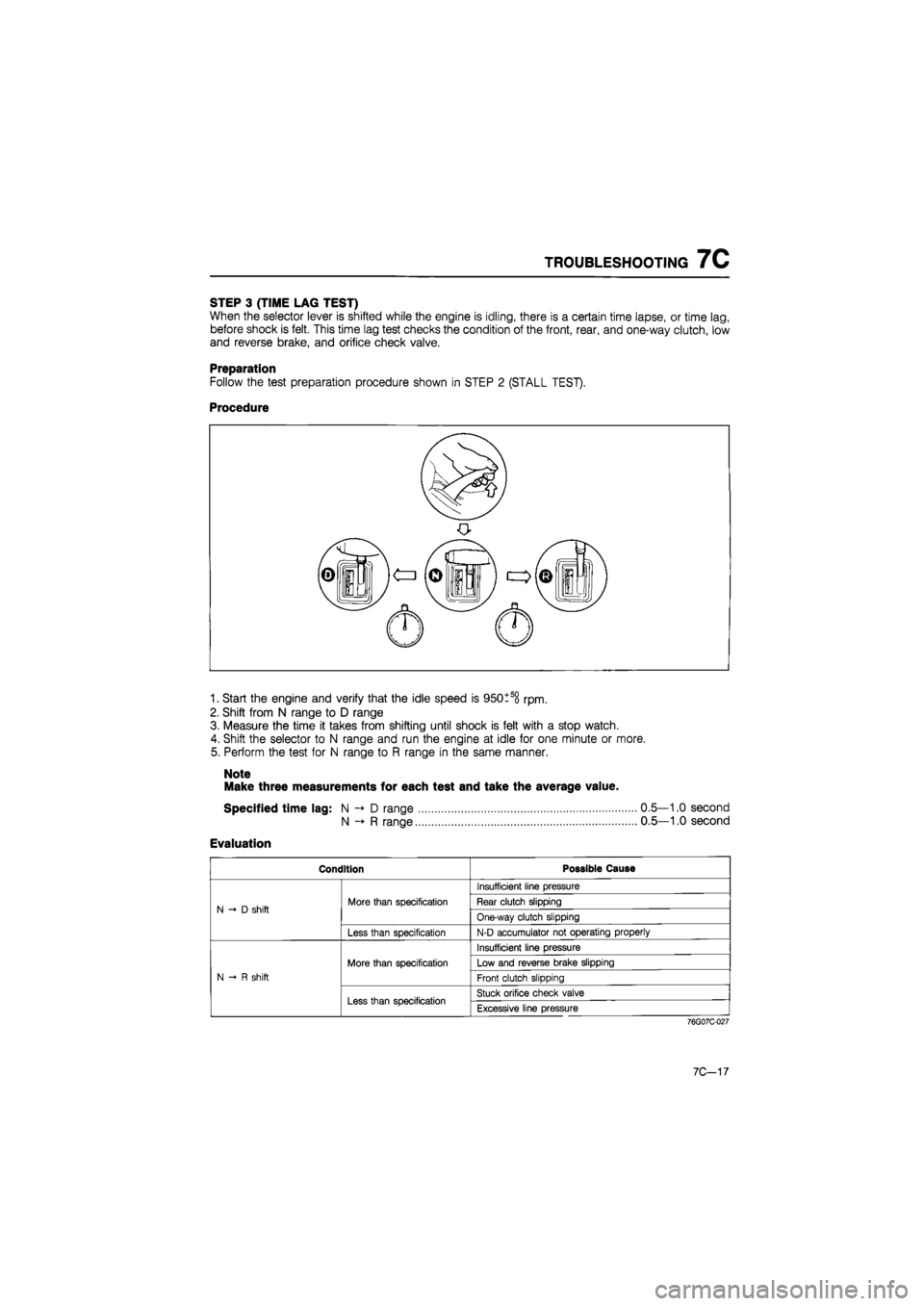
TROUBLESHOOTING 7C
STEP 3 (TIME LAG TEST)
When the selector lever is shifted while the engine is idling, there is a certain time lapse, or time lag,
before shock is felt. This time lag test checks the condition of the front, rear, and one-way clutch, low
and reverse brake, and orifice check valve.
Preparation
Follow the test preparation procedure shown in STEP 2 (STALL TEST).
Procedure
1. Start the engine and verify that the idle speed is 950tso rpm.
2. Shift from N range to D range
3. Measure the time it takes from shifting until shock is felt with a stop watch.
4. Shift the selector to N range and run the engine at idle for one minute or more.
5. Perform the test for N range to R range in the same manner.
Note
Make three measurements for each test and take the average value.
Specified time lag: N D range 0.5—1.0 second
N R range 0.5—1.0 second
Evaluation
Condition Possible Cause
N -» D shift More than specification
Insufficient line pressure
N -» D shift More than specification Rear clutch slipping N -» D shift More than specification
One-way clutch slipping N -» D shift
Less than specification N-D accumulator not operating properly
N-R shift
More than specification
Insufficient line pressure
N-R shift
More than specification Low and reverse brake slipping
N-R shift
More than specification
Front clutch slipping N-R shift
Less than specification Stuck orifice check valve
N-R shift
Less than specification Excessive line pressure
76G07C-027
7C-17
Page 1132 of 1865
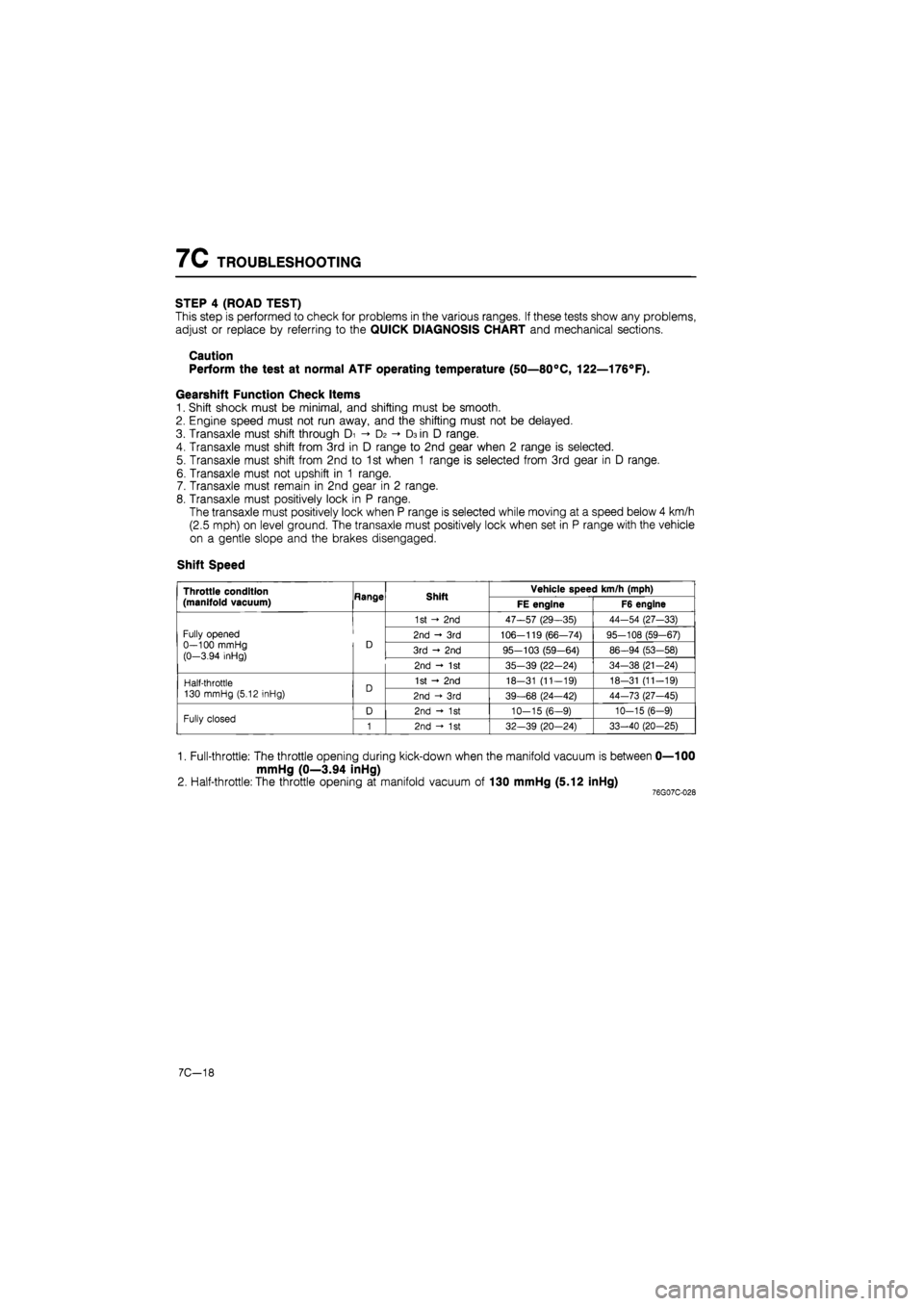
7C TROUBLESHOOTING
STEP 4 (ROAD TEST)
This step is performed to check for problems in the various ranges. If these tests show any problems,
adjust or replace by referring to the QUICK DIAGNOSIS CHART and mechanical sections.
Caution
Perform the test at normal ATF operating temperature (50—80°C, 122—176°F).
Gearshift Function Check Items
1. Shift shock must be minimal, and shifting must be smooth.
2. Engine speed must not run away, and the shifting must not be delayed.
3. Transaxle must shift through Di D2 -»• D3 in D range.
4. Transaxle must shift from 3rd in D range to 2nd gear when 2 range is selected.
5. Transaxle must shift from 2nd to 1st when 1 range is selected from 3rd gear in D range.
6. Transaxle must not upshift in 1 range.
7. Transaxle must remain in 2nd gear in 2 range.
8. Transaxle must positively lock in P range.
The transaxle must positively lock when P range is selected while moving at a speed below 4 km/h
(2.5 mph) on level ground. The transaxle must positively lock when set in P range with the vehicle
on a gentle slope and the brakes disengaged.
Shift Speed
Throttle condition
(manifold vacuum) Hange Shift Vehicle speed km/h (mph) Throttle condition
(manifold vacuum) Hange Shift FE engine F6 engine
Fully opened 0—100 mmHg (0-3.94 inHg)
D
1st - 2nd 47—57 (29—35) 44-54 (27-33)
Fully opened 0—100 mmHg (0-3.94 inHg)
D 2nd - 3rd 106-119 (66—74) 95-108 (59-67) Fully opened 0—100 mmHg (0-3.94 inHg)
D 3rd - 2nd 95-103 (59-64) 86-94 (53-58)
Fully opened 0—100 mmHg (0-3.94 inHg)
D
2nd - 1st 35-39 (22-24) 34-38 (21-24)
Half-throttle 130 mmHg (5.12 inHg) D 1st - 2nd 18-31 (11-19) 18-31 (11-19) Half-throttle 130 mmHg (5.12 inHg) D 2nd -»• 3rd 39-68 (24—42) 44-73 (27-45)
Fully closed D 2nd - 1st 10-15 (6-9) 10-15 (6-9) Fully closed 1 2nd - 1st 32—39 (20-24) 33-40 (20-25)
1. Full-throttle: The throttle opening during kick-down when the manifold vacuum is between 0—100
mmHg (0—3.94 inHg)
2. Half-throttle: The throttle opening at manifold vacuum of 130 mmHg (5.12 inHg) 76G07C-028
7C-18
Page 1134 of 1865
7C TROUBLESHOOTING
STEP 5 (OIL PRESSURE TEST)
This step determines line pressure, and governor pressure to check the hydraulic components and
for oil leakage.
Line Pressure Test
Preparation
1. Connect the SST to the line pressure output point.
2. Connect a tachometer to the engine.
3. Follow the test preparation procedure show in STEP 2 (STALL TEST).
Procedure
76G07C-030
1. Start the engine and verify that the idle speed is 950-5° rpm.
2. Shift the selector lever to D range.
3. Read the line pressure at idle.
4. Depress the brake pedal firmly with the left foot, and gradually depress the accelerator pedal with
the right foot.
5. Read the line pressure as soon as the engine speed becomes constant; then release the accelera-
tor pedal.
Caution
Steps 4 to 5 must be done within 5 seconds.
5. Shift the selector lever to N range and let the engine idle for one minute or more.
6. Read the line pressure at idle and engine stall speeds for each range in the same manner.
7C—20
Page 1137 of 1865
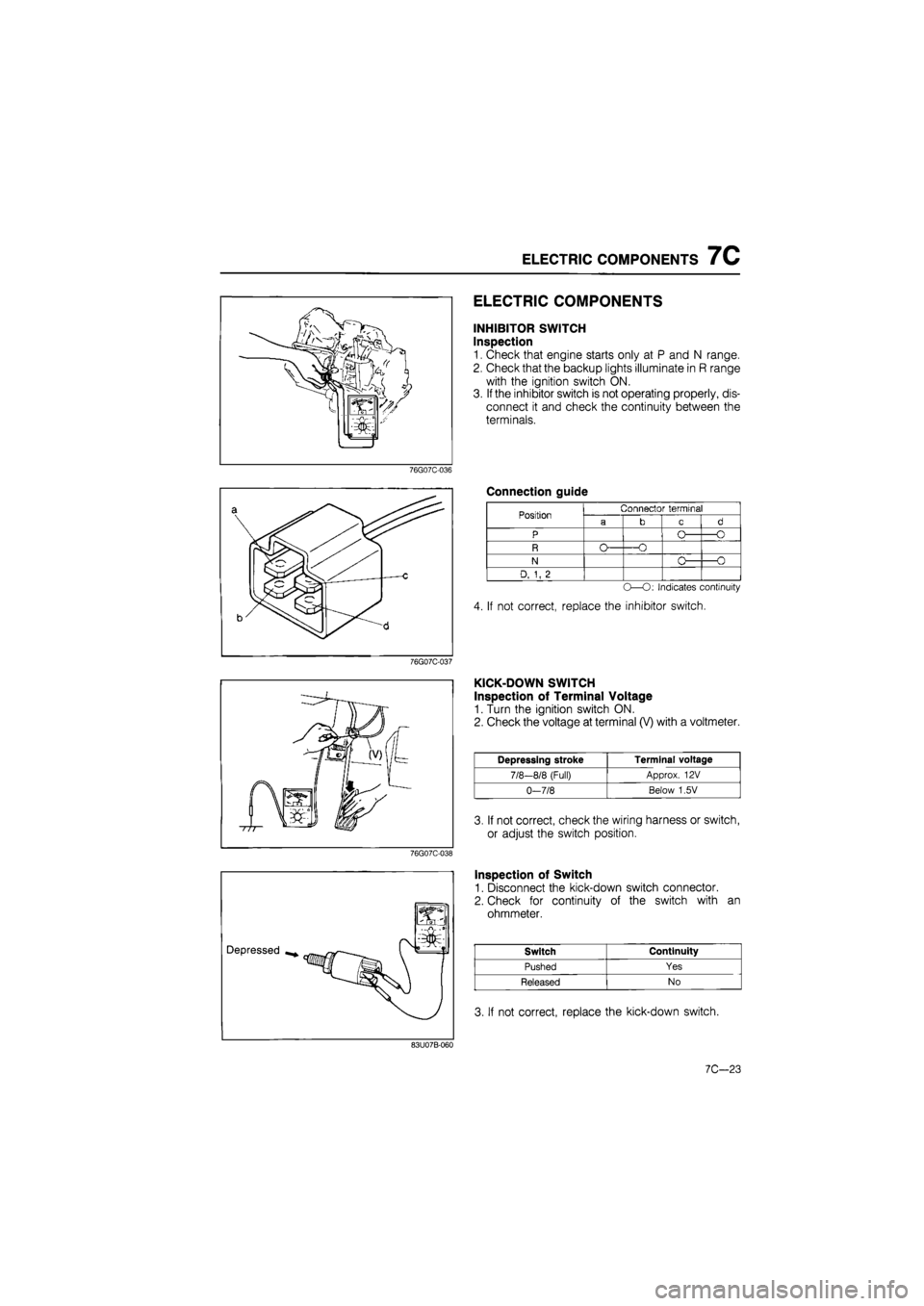
ELECTRIC COMPONENTS 7C
76G07C-036
76G07C-037
76G07C-038
ELECTRIC COMPONENTS
INHIBITOR SWITCH
Inspection
1. Check that engine starts only at P and N range.
2. Check that the backup lights illuminate in R range
with the ignition switch ON.
3. If the inhibitor switch is not operating properly, dis-
connect it and check the continuity between the
terminals.
Connection guide
Position
N
D, 1, 2
Connector terminal
-O
O -O
-O
O—O: Indicates continuity
4. If not correct, replace the inhibitor switch.
KICK-DOWN SWITCH
Inspection of Terminal Voltage
1. Turn the ignition switch ON.
2. Check the voltage at terminal (V) with a voltmeter.
Depressing stroke Terminal voltage
7/8-8/8 (Full) Approx. 12 V
0-7/8 Below 1,5V
3. If not correct, check the wiring harness or switch,
or adjust the switch position.
Inspection of Switch
1. Disconnect the kick-down switch connector.
2. Check for continuity of the switch with an
ohmmeter.
Switch Continuity
Pushed Yes
Released No
3. If not correct, replace the kick-down switch.
83U07B-060
7C—23
Page 1139 of 1865
ON-VEHICLE MAINTENANCE 7C
ON-VEHICLE MAINTENANCE
AUTOMATIC TRANSAXLE FLUID (ATF)
Inspection for Fluid Leaks
Check for fluid leaks; the following figure shows the locations where fluid leakage may possibly occur.
1. Kick-down solenoid
2. Vacuum diaphragm
3. Manual shaft
4. Speedometer driven gear
5. Oil level tube
6. Governor cover
7. Governor
8. Oil pan
9. Oil pump
10. Inhibitor switch
11. Transaxle case
12. Oil pump
13. Square head plugs
14. Bearing cover
15. Drive shaft
76G07C-041
©
i
©
[JdQ©
I
Inspection of Level
1. Apply the parking brake and block the wheels to
prevent the vehicle from rolling.
Note
Place the car on a flat, level surface.
2. Run the engine so that the automatic transaxle fluid
reaches operating temperature.
3. While the engine is idling, shift the select lever from
P to 1 and back again.
4. Let the engine idle.
5.Shift the select lever to P.
76G07C-042
7C-25
Page 1143 of 1865
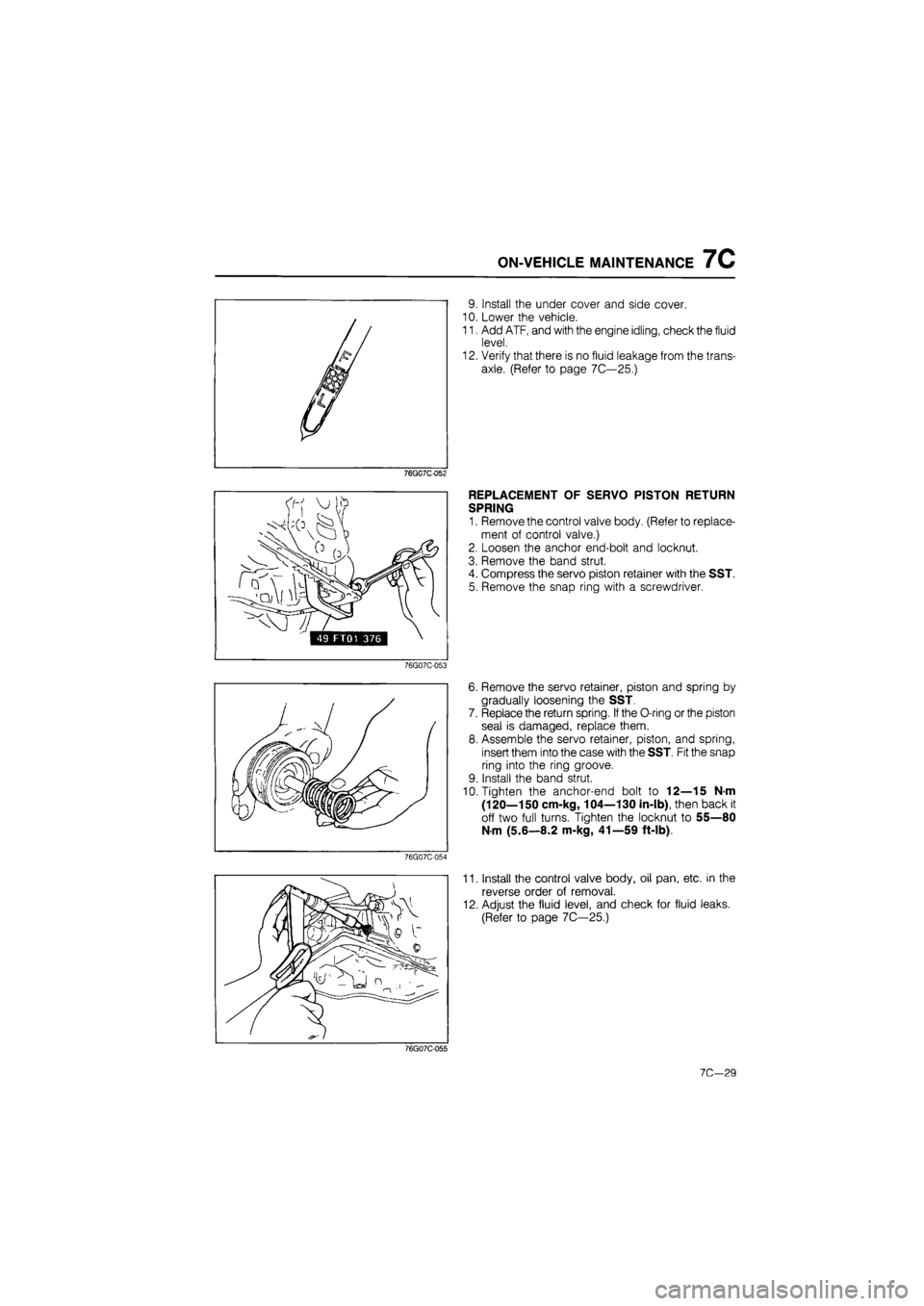
ON-VEHICLE MAINTENANCE 7C
9. Install the under cover and side cover.
10. Lower the vehicle.
11. Add ATF, and with the engine idling, check the fluid
level.
12. Verify that there is no fluid leakage from the trans-
axle. (Refer to page 7C—25.)
76G07C-052
REPLACEMENT OF SERVO PISTON RETURN
SPRING
1. Remove the control valve body. (Refer to replace-
ment of control valve.)
2. Loosen the anchor end-bolt and locknut.
3. Remove the band strut.
4. Compress the servo piston retainer with the SST.
5. Remove the snap ring with a screwdriver.
76G07C-053
76G07C-054
6. Remove the servo retainer, piston and spring by
gradually loosening the SST.
7. Replace the return spring. If the O-ring or the piston
seal is damaged, replace them.
8. Assemble the servo retainer, piston, and spring,
insert them into the case with the SST. Fit the snap
ring into the ring groove.
9. Install the band strut.
10. Tighten the anchor-end bolt to 12—15 N-m
(120—150 cm-kg, 104—130 in-lb), then back it
off two full turns. Tighten the locknut to 55—80
N m (5.6—8.2 m-kg, 41—59 ft-lb).
11. Install the control valve body, oil pan, etc. in the
reverse order of removal.
12. Adjust the fluid level, and check for fluid leaks.
(Refer to page 7C—25.)
76G07C-055
7C—29
Page 1184 of 1865
7C INSPECTION AND REPAIR
76G07C-181
Mr
76G07C-182
76G07C-183
Inspection
Check the following and replace any faulty parts.
1. Damaged or worn piston
2. Weakened return spring
Free length of spring:
FE engine: 48.0 mm (1.89 in)
F6 engine: 45.5 mm (1.79 in)
Assembly
1. Apply ATF to the inner and outer seal rings, and
install them onto the servo piston.
2. Apply ATF to the seal ring, and install it onto the
servo retainer.
3. Assemble the servo retainer and servo piston.
BRAKE BAND
Inspection
Check the following and replace any faulty part.
1. Damaged or worn brake band
76G07C-184
7C-70
Page 1199 of 1865
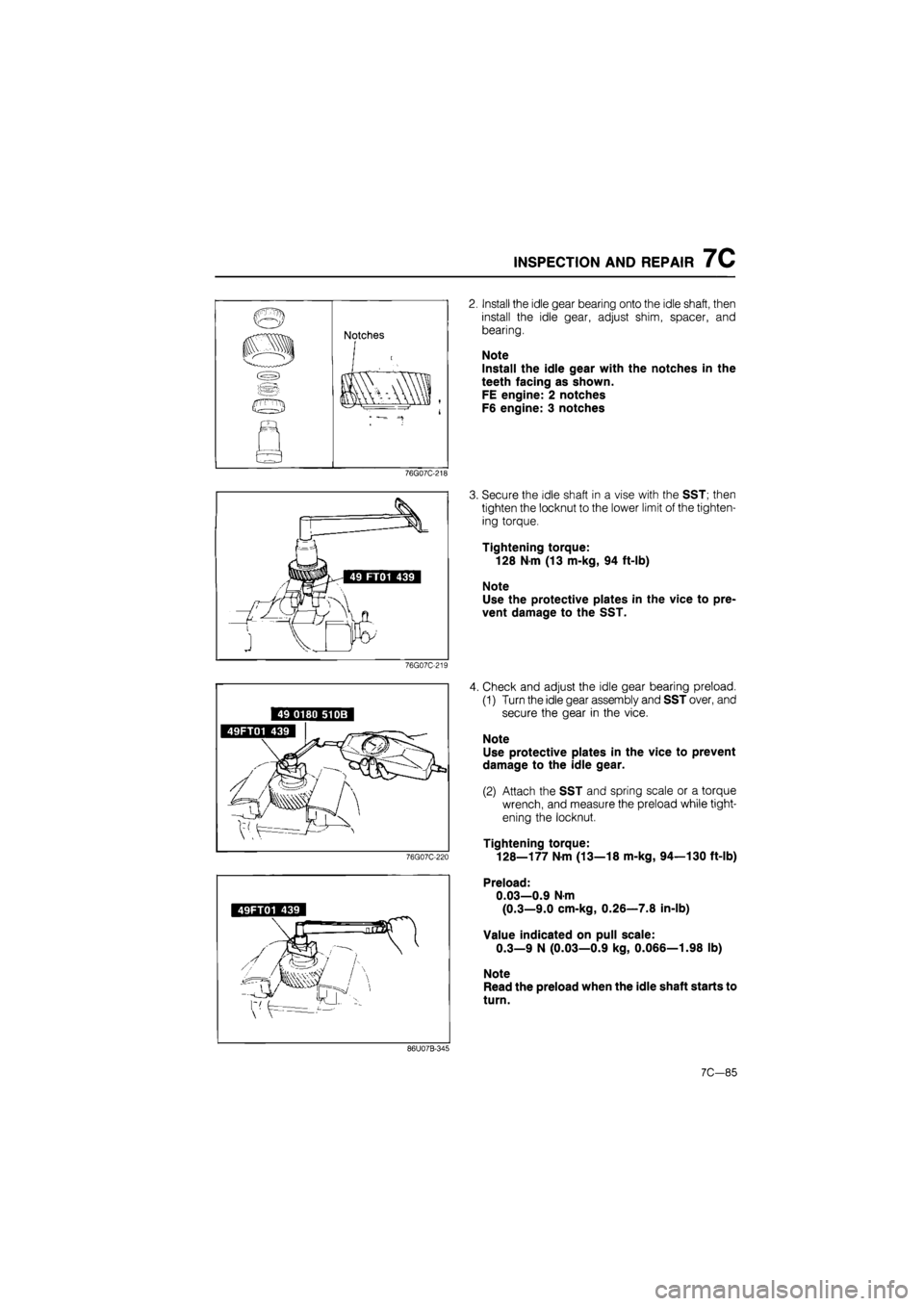
INSPECTION AND REPAIR 7C
n Notches
m
«
m
«
i * •"-=- —*
76G07C-218
49FT01 439
86U07B-345
Install the idle gear bearing onto the idle shaft, then
install the idle gear, adjust shim, spacer, and
bearing.
Note
Install the idle gear with the notches in the
teeth facing as shown.
FE engine: 2 notches
F6 engine: 3 notches
Secure the idle shaft in a vise with the SST; then
tighten the locknut to the lower limit of the tighten-
ing torque.
Tightening torque:
128 N-m (13 m-kg, 94 ft-lb)
Note
Use the protective plates in the vice to pre-
vent damage to the SST.
Check and adjust the idle gear bearing preload.
(1) Turn the idle gear assembly and SST over, and
secure the gear in the vice.
Note
Use protective plates in the vice to prevent
damage to the idle gear.
(2) Attach the SST and spring scale or a torque
wrench, and measure the preload while tight-
ening the locknut.
Tightening torque:
128—177 N-m (13—18 m-kg, 94—130 ft-lb)
Preload:
0.03—0.9 Nm
(0.3—9.0 cm-kg, 0.26—7.8 in-lb)
Value indicated on pull scale:
0.3—9 N (0.03—0.9 kg, 0.066—1.98 lb)
Note
Read the preload when the idle shaft starts to
turn.
7C—85